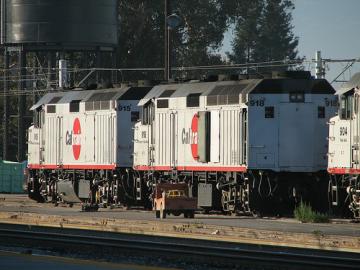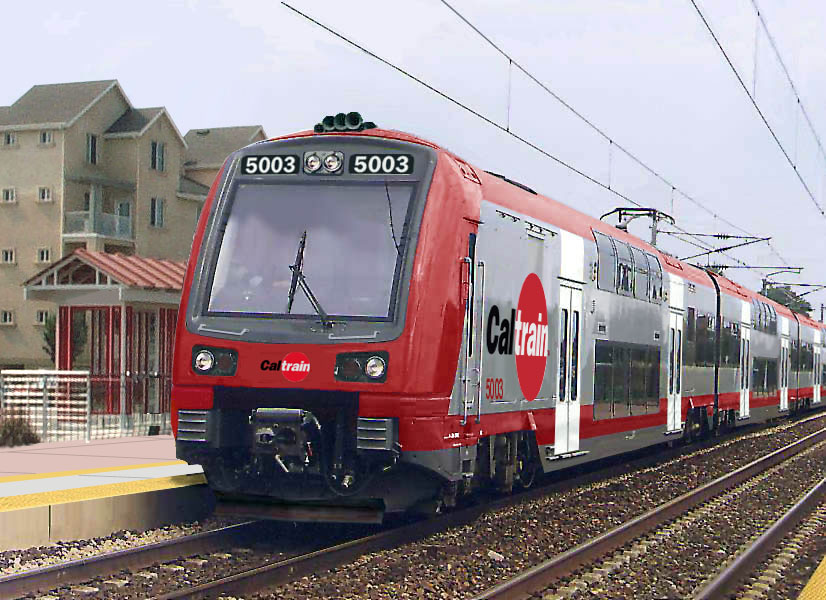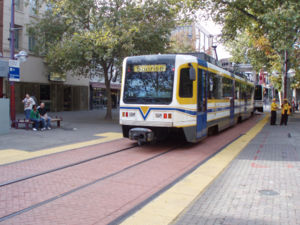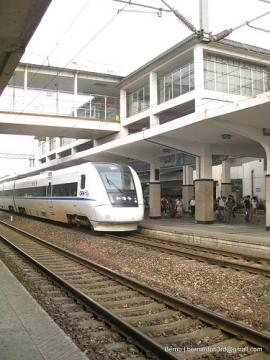Trains are vehicles that operate on tracks.
In transit/railroad terms, a ”’car”’ means a single rail vehicle. A train means multiple rail cars connected together (2-car trains, 5-car trains).
Passenger trains vary in speed and distance. Some trains in the East Coast and abroad can operate faster than 125 mph connecting major cities. Some rail lines in the Bay Area function like a local bus with stops every few city blocks.
Below are the basic passenger train types. These categories, however, are shades of gray because a train system may have more than one function (Amtrak inter-city trains serving commuters). Also, train systems that have similar functions can have major differences in underlying technologies and legal requirements.
High speed trains
High speed trains are generally defined as trains that can operate 125mph or faster. High speed trains generally connect large metropolitan areas (with very few stops in between) and are meant to be competitive with airlines in terms of overall travel time.
Although High Speed Rail trains in general are compatible with regular passenger and freight trains (and often share tracks at major stations in Europe), it requires dedicated tracks to operate at high speed.
High speed trains current operates in Europe (France, Germany, Britain, Spain, Italy, and more), Japan, China, South Korea, and Taiwan. In North America, Amtrak’s Acela (Boston – Washington DC) meets the definition of of high speed rail, but uses heavier trainsets than its European and Asian counterparts.
The proposed high speed rail system in California would use trainsets similar to those in Europe and Asia.
Inter-city trains
Inter-city trains generally mean trains traveling long distances connecting metropolitan areas. Although the distances covered by some of these trains are comparable to airlines, inter-city trains generally operate at highway speed. Long distance inter-city trains may provide amenities not found on most other forms of transportation, including sleeper-cars and cafe/dining cars.
Amtrak is the operator of inter-city trains in the United States. Although Amtrak is much slower than airlines, inter-city trains serve small cities between metropolitan areas aren’t served by airlines.
Historically, inter-city passenger trains are operated by railroad companies that also haul freight trains. After World War II, ridership on passenger trains steadily declined with competition from automobiles and airlines. At that time, many railroads wanted to abandon passenger train service to cut operating losses. In 1971, Amtrak was established by Congress to nationalize inter-city passenger rail business. Outside the Northeast Corridor (Boston and DC), Amtrak uses tracks owned by various freight railroads.
Commuter/regional trains

Caltrain locomotives (Source)
Commuter trains generally mean trains connecting suburban areas with the central city and primarily serves riders to and from work. Commuter trains typically run on weekdays, during rush hours, and only in the peak directions. A prime example would be Altamont Commuter Express, which run from Stockton to San Jose during weekday mornings, and from San Jose to Stockion during weekday afternoons. However, commuter rail systems like Caltrain and Metrolink can run trains all day in both directions.
In the United States, typical commuter trains are locomotive-haul. The locomotive on one end of the train either pulls the unpowered passenger cars (from the front) or pushes them (from the back) to make them move. Most locomotives are powered by diesel fuel and some (in the East Coast) by electricity.
Many commuter trains in Europe, as well as some in the U.S. use electric multiple units instead of locomotives. In a multiple-unit train, every car (or every other car) in the train has motors which are capable of propelling the vehicle. Multiple unit trains are more reliable (with multiple engine/motors rather than one engine) and more efficient (by easily changing train length for peak and off-peak hours).

Proposed Caltrain EMU
Most commuter trains in the U.S. share tracks with Amtrak and freight trains, therefore they are subject to Federal Railroad Administration regulations. FRA regulations require commuter trains to be heavier (in the belief that heavier trains are safer) and less efficient than commuter trains in Europe.
BayRail Alliance goal is to improve Caltrain service by converting its power source from diesel to electric, and use light weight European style rail cars. Caltrain is currently pursuing these goals under Project 2015.
Rapid transit
Rapid transit, which is also known as metro, subway, and heavy rail, mean trains that generally serve the urban-core, have large passenger capacity, and operate totally separate from road traffic. In order to run separately from road traffic in the city-core, rapid transit trains would run either above or underground.
Many major cities (like New York, London, Washington D.C.) have extensive systems that make traveling within a city fast and convenient. BART is the rapid transit system in the Bay Area. However, BART does not serve San Francisco as well as other systems do in their cities.
Because of the grade-separated nature of rapid transit systems, it is generally much more expensive to build per mile compared to light rail and commuter rail. Also, these trains lack seatings and other amentities. Rapid transit technologies such as BART are not cost effective to provide long distance-suburban service.
Light rail

Sacramento LRT
Light rail, which might be also known as trolley and streetcars, mean trains that function as local transit in an urban-core and can operate on the street-level. Compared to rapid transit, light rail costs less, is more pedestrian friendly, but has less passenger capacity. The major advantage with light rail is that it can operate like rapid transit or like local buses, depending on the available infrastructure.
In Sacramento, San Diego, Portland, and San Jose, light rail trains run faster in the suburbs (dedicated tracks) and slower in downtown (street median). In San Francisco, trains operate in mixed traffic outside downtown and underground in downtown. Light Rail stations can be a few city blocks apart in downtown and a mile or more apart in the suburbs.
Most light rail systems are integrated with the local transit network. Fares for most light rail systems are the same as the buses.
Although most light rail can physically share tracks with freight and commuter trains, it is not legally permitted because light rail trains do not meet the weight requirement set by the FRA. FRA however does grant waivers to some systems to share tracks as long as freight trains only run at night when there’s no light rail trains on the same track.
Most light rail systems are electric (powered by overhead wires), but some suburban-only systems (Sprinter in Oceanside, Riverline in New Jersey) run on diesel. The proposed SMART system in the North Bay would run on diesel as well.
Modern streetcar
In some cities such as Portland and Seattle, they have a urban streetcar system that is somewhat compatible but operated separately from their light rail system. Those streetcars typically have smaller dimensions and operate at slower speed than their light rail counterpart. The streetcars are meant to facilitate local circulation in the urban core (and serve as a catalyst for transit oriented developments) rather than connecting nearby suburbs with downtown.
Other cities are planning to build downtown streetcars modeled after Portland and Seattle. Those include Los Angeles and Oakland.
General rail characteristics matrix
The matrix below shows the general characteristics, but every system is somewhat unique.
| Light rail | Rapid transit | Commuter rail | Inter-city rail | High speed rail | |
| Distance between stops | a few blocks to 1 or 2 miles | 1/2 mile to 2 or 3 miles | 1 to 2 miles | 2 to 10 miles | at least 10 miles |
| Max speed | 55-65 mph | 65-70 mph | 79 mph (US) | 79 mph (US) | at least 90 mph |
| Sharing tracks with freight trains | Can share tracks but not at the same time | No | Yes | Yes | Can share tracks only on low speed segments |
| Grade crossings | Can operate on street, mixed traffic | Not permitted | Permitted | Permitted | Not permitted |
| Train frequency | 3-30 minutes | 3-20 minutes | 15 minutes to hourly (some operate only during weekday peak hours) | Hourly to once a day, or even three trips a week. | 15 minutes to hourly |
| Amenities | Large space for standees | Restroom | Restroom, business class, sleeper (longer distance), cafe/dining car | Restroom, business class, cafe car |
